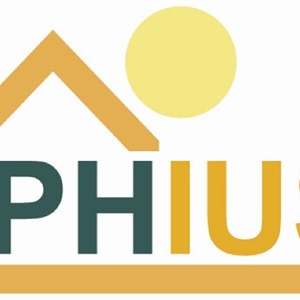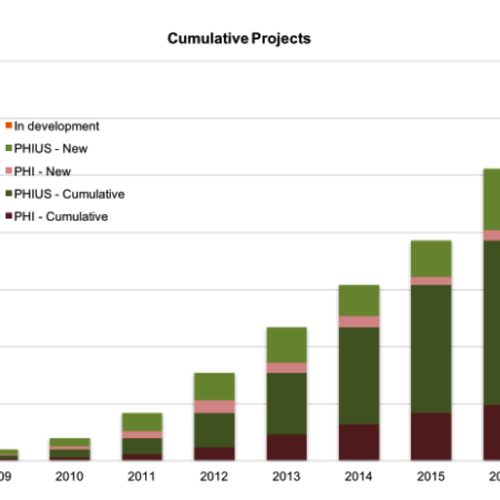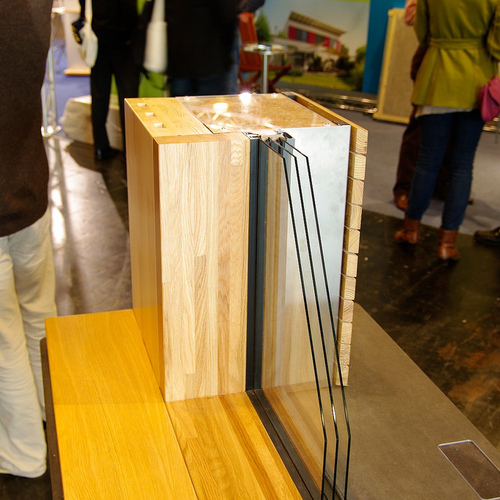Image Credit: Northwin
Image Credit: Northwin A window made by an Oakland, Calif., company has been certified by the Passive House Institute, bringing to three the number of North American manufacturers of PHI-certified products.
Image Credit: Wooden Window Inc.
Builders hoping to meet the Passivhaus energy efficiency standard can now choose between five window manufacturers in North American, four in the U.S. and one in Canada.
Three of the manufacturers have had windows certified by the Passivhaus Institut (PHI) in Germany, the other two by the rival U.S. organization, Passive House Institute U.S. (PHIUS).
Passivhaus designers are free to use any windows they like, but using a certified window allows them to plug established values into energy modeling software. Houses certified under the Passivhaus standard must meet stringent guidelines on energy consumption, so the thermal performance of windows is crucial.
Europe has many certified window makers, but lead times for North American builders can be lengthy, and the windows are pricey. With four, and likely five, manufacturers now in North America, builders on this side of the Atlantic shouldn’t have to wait as long for delivery, and they may find it easier to shop on the basis of price.
Companies whose windows have won certification, and the certifying agency, are:
- Alpen High Performance Products of Longmont, Colo. (PHIUS).
- Northwin of Vancouver, Canada (PHI).
- Marvin Windows and Doors of Warroad, Minn. (PHIUS)
- Casagrande Woodworks of Paso Robles, Calif. (PHI).
- Wooden Window Inc. of Oakland, Calif. (PHI).
Two systems are not the same
It’s not clear whether it will make any practical difference to builders whether the windows they select are certified by PHIUS or its European counterpart, PHI. But there are fundamental differences in how these two organizations have approached window certification.
Technical requirements for PHI are published on its web site, along with a list of companies whose products have been approved. Anyone can visit the site and go to the list of certified windows, which includes the product name, the manufacturer and what the window is made from.
Each entry also includes a link showing results for a specific window, such as the Synergist made by Casagrande Woodworks. The listing includes U-factors plus a graphic showing how well the window performed for a particular climate zone, from an “A” rating as an “advanced component” to “not suitable for Passive Houses.” In this particular example for Casagrande, the rating is for a window frame to be used in a cool, temperate climate.
PHIUS launched its Certified Data for Window Performance Program last November. In announcing it, PHIUS chief scientist Graham Wright wrote a blog describing the need for a North American certification system.
One key difference: A manufacturer’s window can flunk the European test, but there’s no such thing as a failing grade in the U.S. program.
“We’ve set no pass/fail criteria on U-values,” Wright wrote, “only guidelines as to the thermal performance levels appropriate to various North American climate regions.”
PHIUS described the program as a means of “certifying the accuracy and appropriateness of custom energy performance data for windows and their components needed to accurately model passive house energy balances.”
At least for now, PHIUS does not publish a list of certified windows on its web site, nor are there any recommendations matching particular climate zones to window performance.
But Wright said in a telephone interview that information could be added to the web site as early as August and certainly no later than October, when the North American Passive House conference takes place.
Long range, Wright said the PHIUS goal is to combine the best features of the European and National Fenestration Rating Council testing protocols.
“The European methods do a better job of handling windows of different sizes and they’re also climate specific,” he said. “The NFRC methods to a better job of handling a lot of different glass options and they appear to have more sophisticated fundamental algorithms.
“The main goal is we want to enable our Passive House consultants to do accurate energy modeling, or at least you might say accurate enough without trying to simulate every photon that’s bouncing around in the window,” he added. “We want to find the right compromise between complexity and accuracy.”
The European standard is ‘very stringent,’ while the U.S. program is more adaptable
Casagrande Woodworks Vice President Craig Bower said he understood testing criteria in U.S. and European certification programs are a little different, and that one reason for choosing to go with the PHI program was that it was known to be “very stringent.”
“If you get European certification, you’ve covered all your bases,” he said.
Alison Ray, senior sales representative for Alpen, said the company studied the two certification programs at length before electing to go with PHIUS. Investing in the PHIUS program, she said, was a way of making testing easier for North American window manufacturers. And a certification process developed on this side of the Atlantic would be more compatible with performance data published by the NFRC.
“The Passivhaus European process uses a different calculation metric than we use here in the United States and it does favor, in terms of performance, the windows that are made in Europe,” she said. “So if I could take that same window and measure it to NFRC standards the European window would actually look worse than it does in Passivhaus standards. By that same token, if I take my window that looks great in NFRC and I go to the European standard it looks a lot worse than it actually is.”
The PHIUS certification program also acknowledges that there’s more than one climate zone here, and that a simple pass-fail threshold may not be as useful in North America as one that can be adapted to different regions, Ray said.
“PHIUS recognizes that not all passive houses in the United States are going to be in a climate like Germany’s,” she added. “So why have a pass-fail threshold based on Germany that’s not applicable here? Instead of saying pass-fail, they say we’re going to certify your data, get a third-party verification that this is real information and you can use that data in passive houses all over the United States.”
In the end, Ray said, what really matters is getting the numbers to work in energy modeling, not whether a window has been certified by anyone.
[Author’s note: This article was updated on July 17, 2013, to reflect the fact that Wooden Window’s CaliPassiv window has been certified by the PHI.]
Weekly Newsletter
Get building science and energy efficiency advice, plus special offers, in your inbox.
















5 Comments
'and the windows are
'and the windows are pricey'
this depends. we've seen US non-PH window orders for 'code minimum' specs that far exceeded what you can obtain from EU (including PHI-certified glass and frames). yes, the lead times are longer, but there really ain't a way around that unless smartwin and optiwin want to start building frames here, and guardian decides to manufacture their high performance glass in N.A.
a design-oriented window nerd can dream, can't he?
the PHI certification includes the reality that there is more than one climate zone, and has devoted oodles of time and money to legitimately studying this very issue. is Ray contending that they don't? the PHI has looked at passivhaus from mexico to china, yekaterinburg to africa. moscow alone has a higher population than ALL north american locales with same or higher HDDs (and almost across the board, it's much easier to meet PH in NA).
in the end, 'getting the numbers to work in energy modeling' sounds like a lot of room for fudging to make manufacturers happy, rather than the PHI certification - which is a verification AND validation that the numbers being utilized in PHPP are correct.
the PHIUS window certification is a farce, a stick in the eye to the greater passivhaus community and will only fracture and damage the high performance industry. dumb, on all accounts.
PHI VS PHIUS window certification
How can GBA best help us make sense of these two systems? Is it enough to put a statement in quotations, or should the material first be checked for factual accuracy? Understanding and comparing the science behind two systems for analyzing window performance is not a simple task. Yet that is what I would like to see. This is an important topic and I would like to see GBA hire an author up to that task, explain there findings in laymen’s terms.
Response to Thomas Nedelsky
Thomas,
GBA always strives for factual accuracy in all of our reporting. It's fair to say that GBA is probably the best U.S. source of information on Passivhaus windows. We have covered the topic extensively in the past, and are committed to further coverage of the topic in the future.
NFRC vs PHI vs PHIUS
Tom,
I've created a presentation that attempts to provide the comparison you are looking for: http://www.slideshare.net/Bronwynb/nfrc-vs-phi-vs-phius-window-certification-for-us
This should hopefully also clear up Ms. Ray's misunderstanding that the performance requirements set by PHI for certification actually do apply to most of North America. Please be aware that neither PHI nor PHIUS have verified the accuracy of my presentation. The NFRC segment was reviewed by a friend of mine at LBNL who advises the NFRC. I will add corrections and additions from both PHI and PHIUS, as necessary.
I'm also able to confirm that PHI has made a commitment to issue verified performance data for windows that do not qualify for certification, but can be used in warmer climates. In addition to the certified profile I designed in collaboration with Wooden Window, we will be producing a 2-pane, insulated sash profile specifically designed for warmer climates. This profile may be the first to carry the PHI verified data label - however that is named.
cost effectiveness
Short of requesting bids from these new players for an upcoming PH project, can anybody here shed some light on cost comparisons between these new guys and, say Intus Windows? Will any of these come close to meeting Intus' price points? I am leaning toward Intus uPVC for their Q:P ratio, so am currently looking at roughly $30-40/ft2 of glazing to compare to...
Thanks!
Log in or create an account to post a comment.
Sign up Log in